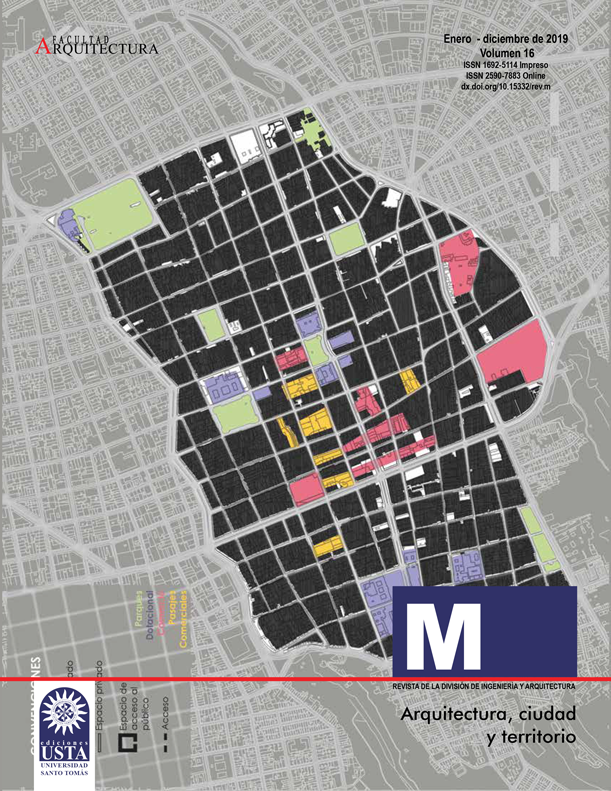THE OVAL VAULTS IN THE CHAPEL OF SAN CARLOS DE PEROTE FORTRESS: AN EXAMPLE OF MODERN MECHANICS IN THE ILLUSTRATED AMERICA
DOI:
https://doi.org/10.15332/rev.m.v16i0.2473Keywords:
Fortification, Perote, mechanics, vaults, ovalAbstract
The chapel of the San Carlos de Perote Fortress is a significant example of introduction of modern mechanical principles illustrated in the Mexican-Latin American historical-constructive panorama. The military engineer Manuel de Santisteban, author of the defensive work, endowed the architectural complex with a chapel projecting a set of oval guide vaults for its covering. The vaults provide height and magnitude, but above all, for his approach to the catenary shape, they reduce the lateral pushes, verticalize the weights and optimize abutments without the need to incorporate external elements for their support. The use of graphical static and vector calculation to determine the state of equilibrium and its mechanical behavior, shows that the choice of its oval layout corresponds to the need to adapt to the minimum thicknesses of the walls. Military engineers were the first to introduce the structures of catenary arches in Spain in the 18th century, aware of their static benefits for the vaults. This universal Cartesian knowledge of mathematics as a method for the investigation of reality and the scientific calculation of masonry structures was also transmitted in Latin America through military engineering models.
Downloads
References
Broca, A. (2017). La Fortaleza de San Carlos. La más destacada obra defensiva de tierra adentro en el territorio nacional. Editora del Gobierno del Estado de Veracruz.
Calderón, J. A. (1949). Ingenieros militares en Nueva España. Anuario de Estudios Americanos.
Calderón, J. A. (1984). Historia de las fortificaciones en Nueva España. (2ª ed.). Gobierno del Estado de Veracruz, Consejo Superior de Investigaciones Científicas. Escuela de Estudios Hispanoamericanos.
Capel, H. (1983). Los ingenieros militares en España - siglo XVIII. Repertorio biográfico e inventario de su labor científica y espacial. Publicacions i Edicions de la Universitat de Barcelona.
Feu, A. (2017). Les voltes de rajola doblada. Construcció i seguretat estructural de les esglésies barroques catalanes. (Tesis doctoral). Departamento de Tecnología de Arquitectura. Universitat Politècnica de Catalunya.
Galindo, J. A. (1996). El conocimiento constructivo de los ingenieros militares del siglo XVIII. Un estudio sobre la formalización del saber técnico a través de los tratados de arquitectura militar. (Tesis doctoral) Escuela Técnica Superior de Arquitectura de Barcelona (Universitat Politècnica de Catalunya).
Gómez, J. (2012). La estática gráfica. Instrumento para el conocimiento estructural intuitivo y el diseño de los arquitectos. (Tesis doctoral) Escuela Técnica Superior de Arquitectura de Valencia (Universitat Politècnica de Valencia).
Heyman, J. (1982). The Masonry Arch. Ellis Horwood, Halsted Press.
Heyman, J. (1995). Teoría, historia y restauración de estructuras de fábrica. Instituto Juan de Herrera.
Lluís, J. (2013). El contexto del saber constructivo del ingeniero militar en el arte abaluartado en el territorio y plaza de Tortosa (1580-1852). En Segovia, F., Nóvoa, M. El arte abaluartado en Cataluña. Estrategia de defensa en el siglo XVIII. Editado por el Ministerio de Defensa de España.
Lluís, J. (2015). La mecánica ilustrada en los ingenieros militares españoles. El proyecto de los almacenes de pólvora (1715-1798). Informes de la Construcción, vol. 67.
Ortiz, J. E. (1993). Arquitectura militar de México. Secretaría de la Defensa Nacional. Ediciones del Equilibrista y Turner Libros.
Sanz, S. E. (2009). Proyecto Ejecutivo para la rehabilitación de la fortaleza de San Carlos. Investigación histórica. Documental. Fortalezas.org. DGOP SEDESMA.







